Trinity Broads Mud Pumping Project (2018)
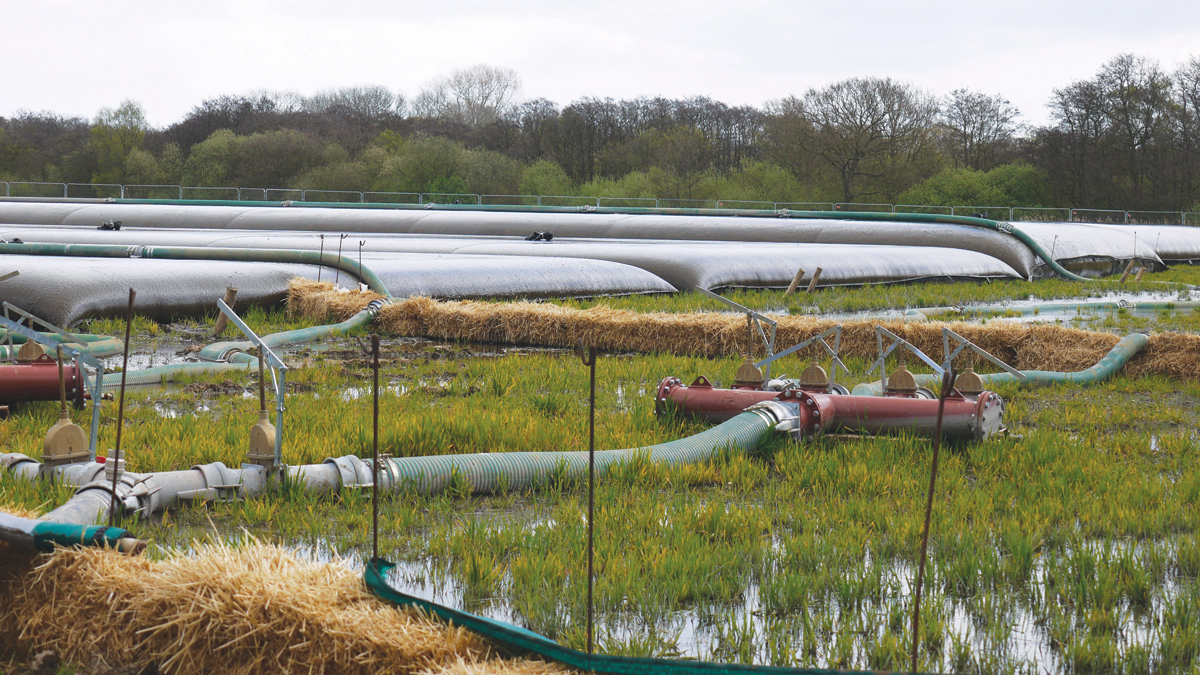
Geobags in operation - Courtesy of Stantec
The Norfolk Broads is a low-lying landscape of interconnected lakes (broads) and streams and large parts are also Sites of Special Scientific Interest (SSSIs) and contain a number of protected species of flora and fauna. One area of the Norfolk Broads; the Trinity Broads, provides raw water to Ormesby Water Treatment Works (WTW) operated by Essex and Suffolk Water (ESW), serving a population of approximately 84,000 people. For abstraction consent purposes and to protect the delicate ecology, a number of shallow areas within the Broads needed to be dredged of sediment.
Site setting and project background
Trinity Broads comprise of five interconnected shallow lowland lakes including Ormesby, Ormesby Little, Rollesby, Lily and Filby Broads. They are of national and international importance, supporting a rich assemblage of aquatic plants, wet carr, woodland, swamp communities, breeding and wintering birds, and invertebrates, including many which are nationally rare or scarce, and are covered by, or are immediately adjacent to, a number of designations:
- The Broadland Special Protection Area and Ramsar site.
- The Broads Special Area of Conservation (SAC).
- Trinity Broads Site of Special Scientific Interest (SSSI).
Species of particular importance include breeding Eurasian (or great) bittern and the western marsh harrier, and over wintering hen harrier, Bewick’s swan, whooper swan, and gadwall. The waters are important for stoneworts and two species of water snail.
The Trinity Broads provides raw water to ESW’s Ormesby WTW. The abstraction permit dictates that a minimum water column thickness must be maintained during abstraction in order to protect the unique environment. Over time significant sediment had built up in areas of the broads, which reduced the water column thickness and would limit ESWs ability to abstract water. Therefore ESW abstraction operations were not resilient to future changing environmental conditions.
In order to improve resilience and to give ESW a greater range of operating conditions, a number of shallow areas within the Broads needed to be dredged of sediment.
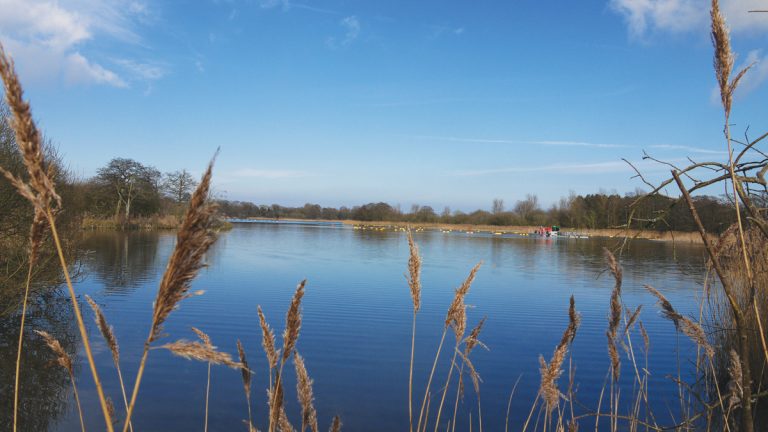
The Trinity Broads environment – Courtesy of Stantec
Undertakings
Stantec UK was asked to provide support and the project team has been working for several years to assess how to carry out the work, from feasibility to developing the proposals, gaining multiple consents and overseeing the works. This project is now complete with around 10,000m3 of sediment successfully pumped out and the regulatory aim of maintaining abstraction consent achieved.
Stantec worked closely with regulators including Natural England, the Environment Agency and the Broads Authority. Along with the support and assistance from the Norfolk Wildlife Trust, Ponds UK (main contractors) and FGS Agri (sub-contractor) the significant challenges associated with working in such a sensitive environment were overcome.
Ecological conditions, permits and constraints
Wintering bird study: Due to the sensitivities of the habitats and species, particularly during the bird breeding season, the Broads Authority, Natural England, the Environment Agency and Norfolk Wildlife Trust advised that mud pumping activities should be undertaken over the winter months. However, the Broads remain sensitive during these months because of the range and assemblages of wintering wildfowl, of national and international importance, they support.
In order to minimise the impact to the overwintering bird species, a Wintering Bird Study was undertaken. The purpose of this was to review Trinity Broads, particularly the proposed mud pumping location, for use by important wintering bird species, to determine whether there was a preferential sequence for the mud pumping to occur in order to minimise disturbance impacts on the birds that may be present.
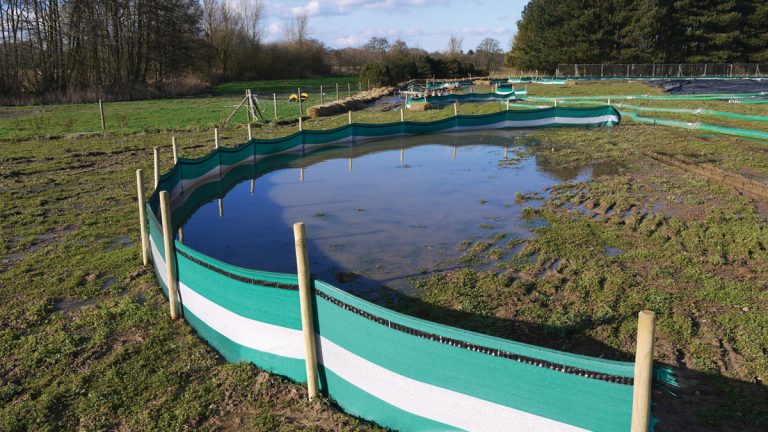
The interceptor curtains – Courtesy of Stantec
The study used Wetland Bird Survey (WeBS) information for the winters between 2010 and 2016. Given the large number of bird species recorded within the data, the study focused on the principal wintering bird species of importance: pochard, tufted duck, shoveler, smew, bittern, gadwall, goldeneye, teal, goosander, and slavonian grebe.
Analysis of the WeBS data for each species and location allowed fluctuations in monthly totals to be identified and the trend of bird numbers over the winter months to be established.
The months with highest sensitivity in terms of greatest bird numbers were determined, as well as the optimum periods for the proposed mud pumping to take place. Although some trends were discernible, detailed analysis of the data suggested that the birds used the whole of Trinity Broads, moving around within the area to feed throughout the winter months.
Habitats Regulations Assessment (HRA) update: An assessment against the Conservation of Habitats and Species Regulations 2010, as amended (the Habitats Regulations) was undertaken by the Broads Authority in 2010 to cover its Sediment Management Strategy Action Plan.
A further assessment had been made in 2013 by ESW as part of their options appraisal for Trinity Broads in line with the Broads Authority assessment. Stantec undertook a review and updated the 2013 assessment to take account of additional and more detailed information relating to the proposed mud pumping activities provided by the appointed contractor.

Geobag nearing full capacity – Courtesy of Stantec
The mud pumping comprised two distinct activities:
- Hydraulic pumping: Using barge-mounted pumps with inlet suction pipes and pipes from the barge to geobags on land.
- Sediment recovery areas: The filling of geobags at margins of recovery areas and the subsequent land spreading, following natural dewatering.
The HRA Update considered the designated features of interest to The Broads SAC, the features of importance to the SSSI and its conservation objectives in terms of the dependent special interest features for which the land was designated. The potential hazards to the features of interest associated with mud pumping activities were identified using the Source-Pathway-Receptor approach and each identified hazard considered in terms of likely significance.
The HRA Update also included a summary of the alternative options and technologies considered, including:
- Mechanical dredging (using barge-mounted mechanical excavators).
- Hydraulic dredging (using suction pumps and direct transfer to land).
- Mud cat auger dredging (mechanical-hydraulic dredging with direct transfer).
- Mechanical excavation with air pumps for transfer to land.
It was concluded that mud pumping using hydraulic techniques would have no likely significant effects; that effects during the works would be temporary and had the potential to result in long-term beneficial effects to the habitats of the Trinity Broads, and the species it supported.
Natural England assent and habitat contingency plan: Both the Wintering Bird Survey and HRA Update reports were required to support the application for Natural England Assent under Section 28G of the Wildlife and Countryside Act 1981 (as amended).
Although Assent was obtained in November 2016 a delay to the start of the mud pumping activities over the winter of 2016/2017 meant that the Assent required extending to cover an extended working period into March and April 2017. To facilitate this, a Habitat Contingency Plan (HCP) was prepared that identified the potential impacts to the habitats and species, and proposed ecological controls to avoid and mitigate for these impacts.
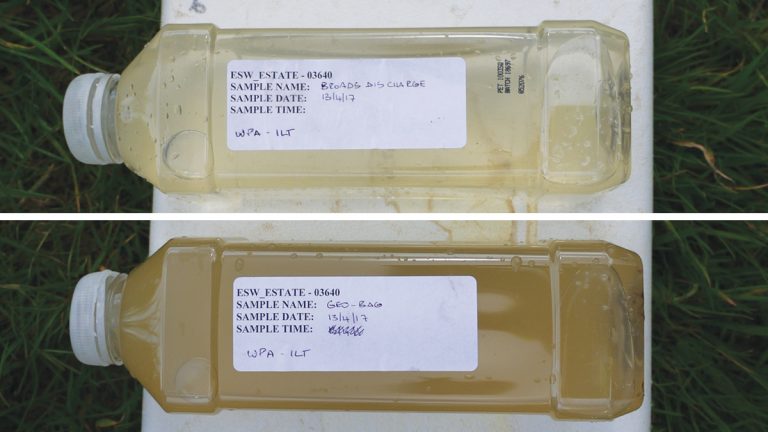
Difference in water quality between discharging from the Geobag (bottom) and re-entering the broad (top) – Courtesy of Stantec
The HCP also had to take account of the starry stonewort, a freshwater green algae that was discovered in 2016 in Ormesby Little Broad, immediately adjacent to a pumping location. This species is listed in Britain as ‘vulnerable’.
Although there were old records for its presence in Filby Broad (most recently for 1903), it was considered that the recently encountered population was a remnant or recently resurrected population and could be vulnerable to losses caused by mud pumping. As a result, amendments were made to the placing of the silt curtain and the mud pumping was re-sequenced to take place in that area as early as possible.
Sediment dredging, dewatering and management
A multidisciplinary team of civil engineers, geotechnical engineers, geo-environmental engineers, hydrologists, hydrogeologists, ecologists and planners from Stantec worked with a core team from ESW and including the Norfolk Wildlife Trust. Over several years, from initial feasibility to developing the proposals and with significant stakeholder and regulatory engagement, and in concert with the habitat work, agreement of multiple consents was attained.
Prior to undertaking the mud pumping, local fish populations were cleared by employing Seine netting or electro-fishing in the area of the stonewort. The sediment dredging activities employed barge mounted hydraulic pumping which drew soft sediment material from the bed whilst being protective of the bed itself. This technique also proved effective in minimising sediment dispersion to water and therefore creating less (harmful) turbidity.
In order to manage the pumped sediment, an approach was required which was protective of the sensitive water, its margins and the land environment, whilst working within the physical constraints of the site. The identification of the landward works commenced with an assessment of likely plots and the suitability of these plots by Savills and the ESW catchment advisor, with consideration of such matters as the preceding crops and the soil binding qualities of any residual stubble or root structures following harvest.
Geobags
The chosen approach was to be an innovative technique for this scale and comprised pumping the sediment directly to large scale ‘geobags’, which were placed on adjacent agricultural land (following landowners’ consent). ‘Geobags’ are high strength non-woven geotextile dewatering tubes, each capable of holding over 1,000m3 of material.
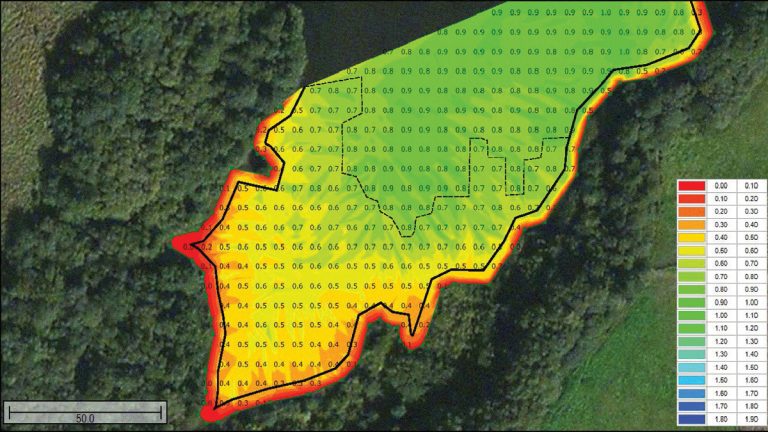
Before dredging, orange and yellow indicating location of sediment – Courtesy of Ponds UK Aquatic Management
The sediment pumping process draws the sediment along with much larger quantities of water, the excess water quickly spilling out of the geobags. It was essential that turbid water did not run directly back into the Broads. This involved complex ground management and filtering methods to manage the run-off.
The particular concerns included the mobilisation of loose soil material in the agricultural areas that would increase turbidity water returning to the Broads and the take-up of nutrients from the soil by the returning water.
Through the use of interceptor curtains to disrupt overland flow paths and the straw bales for filtering, water quality sampling direct from the geobags and at the field margin to confirmed that effective management was achieved.
Following the completion of the dredging work with the solids being held within the geobags and following the initial dewatering (with measurable flows dropping significantly within only a few days), further dewatering continued throughout the summer of 2017. At the end of this period the geobags were opened and the material recovered to land, in accordance with the Environment Agency deployment, by spreading the land into the agreed areas ahead of the following crop sowing period.
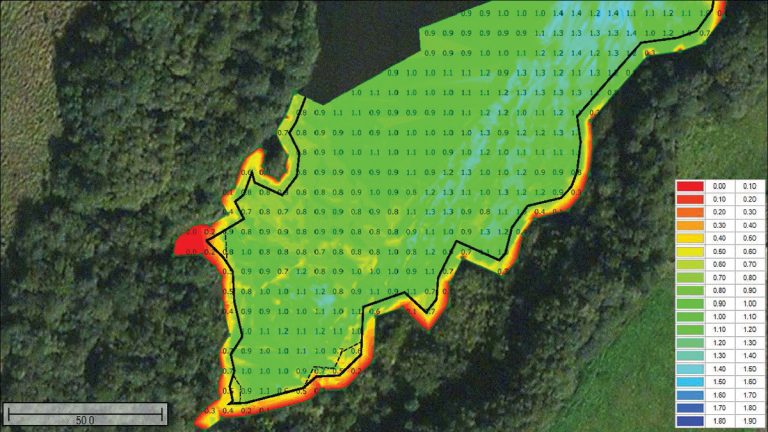
After dredging, widespread green indicating the successful removal of sediment – Courtesy of Ponds UK Aquatic Management
Key participants
The Trinity Broads Mud Pumping Project was a challenging, multi-stakeholder project undertaken within critical timescales. The following were the key participants:
- Designer (feasibility, outline & detailed): Stantec UK
- Dredging work & main contractor: Ponds UK Aquatic Management
- Land management (dewatering and spreading): FGS Agri
- Ecology support: Norfolk Wildlife Trust
- Land & property: Savills
Projects successes
With the perseverance of the whole project team, the project has met the challenges and succeeded; approximately 10,000m3 of sediment successfully dredged, dewatered and spread to land and the abstraction consent for Ormesby WTW secured.




